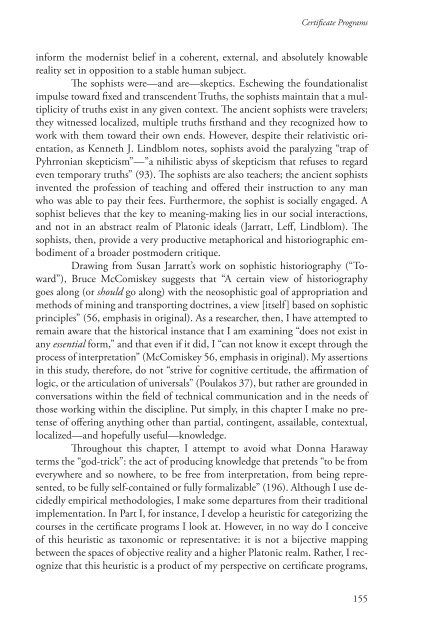Design Discourse- Composing and Revising Programs in Professional and Technical Writing, 2010a
Design Discourse- Composing and Revising Programs in Professional and Technical Writing, 2010a
Design Discourse- Composing and Revising Programs in Professional and Technical Writing, 2010a
Create successful ePaper yourself
Turn your PDF publications into a flip-book with our unique Google optimized e-Paper software.
Certificate <strong>Programs</strong><br />
<strong>in</strong>form the modernist belief <strong>in</strong> a coherent, external, <strong>and</strong> absolutely knowable<br />
reality set <strong>in</strong> opposition to a stable human subject.<br />
The sophists were—<strong>and</strong> are—skeptics. Eschew<strong>in</strong>g the foundationalist<br />
impulse toward fixed <strong>and</strong> transcendent Truths, the sophists ma<strong>in</strong>ta<strong>in</strong> that a multiplicity<br />
of truths exist <strong>in</strong> any given context. The ancient sophists were travelers;<br />
they witnessed localized, multiple truths firsth<strong>and</strong> <strong>and</strong> they recognized how to<br />
work with them toward their own ends. However, despite their relativistic orientation,<br />
as Kenneth J. L<strong>in</strong>dblom notes, sophists avoid the paralyz<strong>in</strong>g “trap of<br />
Pyhrronian skepticism”—”a nihilistic abyss of skepticism that refuses to regard<br />
even temporary truths” (93). The sophists are also teachers; the ancient sophists<br />
<strong>in</strong>vented the profession of teach<strong>in</strong>g <strong>and</strong> offered their <strong>in</strong>struction to any man<br />
who was able to pay their fees. Furthermore, the sophist is socially engaged. A<br />
sophist believes that the key to mean<strong>in</strong>g-mak<strong>in</strong>g lies <strong>in</strong> our social <strong>in</strong>teractions,<br />
<strong>and</strong> not <strong>in</strong> an abstract realm of Platonic ideals (Jarratt, Leff, L<strong>in</strong>dblom). The<br />
sophists, then, provide a very productive metaphorical <strong>and</strong> historiographic embodiment<br />
of a broader postmodern critique.<br />
Draw<strong>in</strong>g from Susan Jarratt’s work on sophistic historiography (“Toward”),<br />
Bruce McComiskey suggests that “A certa<strong>in</strong> view of historiography<br />
goes along (or should go along) with the neosophistic goal of appropriation <strong>and</strong><br />
methods of m<strong>in</strong><strong>in</strong>g <strong>and</strong> transport<strong>in</strong>g doctr<strong>in</strong>es, a view [itself] based on sophistic<br />
pr<strong>in</strong>ciples” (56, emphasis <strong>in</strong> orig<strong>in</strong>al). As a researcher, then, I have attempted to<br />
rema<strong>in</strong> aware that the historical <strong>in</strong>stance that I am exam<strong>in</strong><strong>in</strong>g “does not exist <strong>in</strong><br />
any essential form,” <strong>and</strong> that even if it did, I “can not know it except through the<br />
process of <strong>in</strong>terpretation” (McComiskey 56, emphasis <strong>in</strong> orig<strong>in</strong>al). My assertions<br />
<strong>in</strong> this study, therefore, do not “strive for cognitive certitude, the affirmation of<br />
logic, or the articulation of universals” (Poulakos 37), but rather are grounded <strong>in</strong><br />
conversations with<strong>in</strong> the field of technical communication <strong>and</strong> <strong>in</strong> the needs of<br />
those work<strong>in</strong>g with<strong>in</strong> the discipl<strong>in</strong>e. Put simply, <strong>in</strong> this chapter I make no pretense<br />
of offer<strong>in</strong>g anyth<strong>in</strong>g other than partial, cont<strong>in</strong>gent, assailable, contextual,<br />
localized—<strong>and</strong> hopefully useful—knowledge.<br />
Throughout this chapter, I attempt to avoid what Donna Haraway<br />
terms the “god-trick”: the act of produc<strong>in</strong>g knowledge that pretends “to be from<br />
everywhere <strong>and</strong> so nowhere, to be free from <strong>in</strong>terpretation, from be<strong>in</strong>g represented,<br />
to be fully self-conta<strong>in</strong>ed or fully formalizable” (196). Although I use decidedly<br />
empirical methodologies, I make some departures from their traditional<br />
implementation. In Part I, for <strong>in</strong>stance, I develop a heuristic for categoriz<strong>in</strong>g the<br />
courses <strong>in</strong> the certificate programs I look at. However, <strong>in</strong> no way do I conceive<br />
of this heuristic as taxonomic or representative: it is not a bijective mapp<strong>in</strong>g<br />
between the spaces of objective reality <strong>and</strong> a higher Platonic realm. Rather, I recognize<br />
that this heuristic is a product of my perspective on certificate programs,<br />
155


















